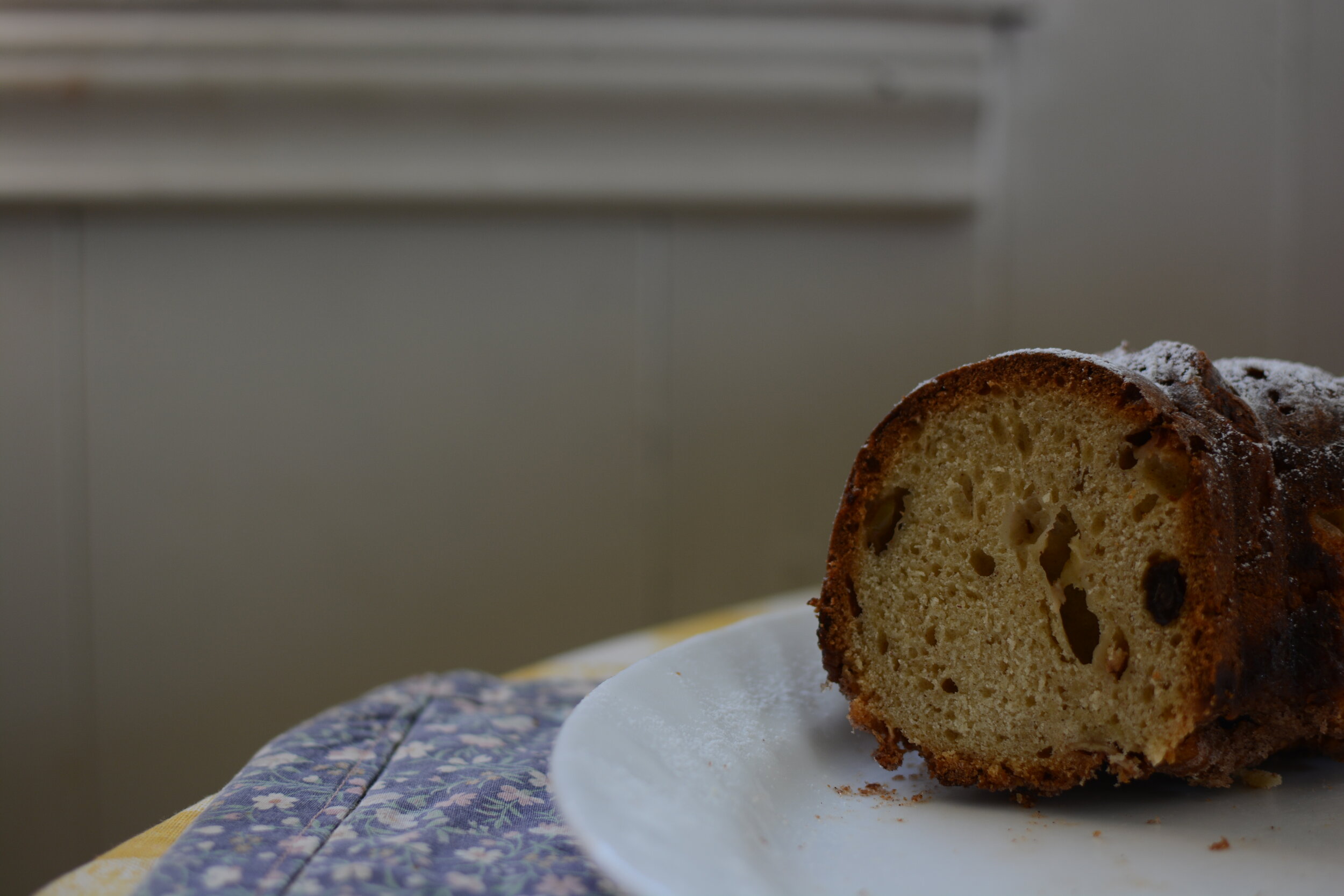sourdough apple cake
Adapted from Granny’s apple cake recipe on the back of the book The Apple Cake by Nienke van Hichtum
Autumn is here in the hills of Vermont and with it all of the special small things we make, do, and notice this time of year. I take great comfort in the turning toward autumn, in the pulling down of books about leaves and harvest and cold Northern winds, the rifling through my recipe box for the butternut soup and the pumpkin daal and the apple cider muffins, the basket of woolens full again on the bench near the front door. There is such joy in returning to clothes that feel like home and the comfort of tiny traditions reclaimed year after year.
Baking with apples starts on Labor Day around here, and doesn’t quit until after Christmas. So far this season we’ve mostly stuck to pies and turnovers (have you seen my recipes for sourdough pie crust and sourdough puff pastry in the current issue of Taproot? They’re what I’ve been cramming full of apples and spice the last few weeks), until I got a bug in my bonnet to make this recipe for Granny’s apple cake that appears on the back of one of our favorite fall stories. I love this story for it’s gentle simplicity, the beauty of the colored-pencil illustrations, and the fable-like journey of Granny as she barters her way from plums from her tree to a bushel of apples to make her special apple cake.
The cake itself is a traditional cake similar to a kugelhopf, leavened with yeast and without any commercial baking powder or baking soda. This is how a home baker would have baked prior to the introduction of those products in the 19th century, and I’ve become intent on understanding the method and using my wild yeast sourdough starter as the leaven. The result is what I would describe as a cross between a commercially leavened cake we would commonly have, and a soft more bread-like brioche. The topping (which ends up on the bottom when baked in a bundt pan) creates a flaky sweet layer that almost reminds me of pastry, and the apples and raisins along the outside caramelize perfectly in the oven for a cake that makes up in texture and rich flavor what it lacks in more conventional cake-like tenderness.
We’ve made it twice, once with apples, raisins, and cinnamon as described above, and a second time with apples and a heaping tablespoon of lemon zest. For the first cake, we let it rise on the counter for about 4 hours before moving it to the pan and baking late that same afternoon, and the second time I mixed up the dough before bed and let it bulk rise on the counter all night and baked it mid-morning the following day. In both cases, the conditions were quite September-in-Vermont cool for rising - between 55 and 65 degrees. I found the overnight bulk of the lemon led to a much more familiar, cakey texture than the shorter length bulk of the cinnamon raisin version. When we make it again, we will stick to the overnight rise when weather is cool, and save the same-day method for one of those unseasonably warm September days.
For each cake we used the topping suggestion on the book and played with it just a bit by leaving the melted butter on the stove a few extra minutes until it was nutty and browned. For the cinnamon-raisin version, we added the cinnamon and sugar to the topping while for the lemon variation we added sugar and the tiniest pinch of nutmeg.
No matter which flavors or method you choose, do yourself a favor and save a bit to slice and toast in butter in a cast iron pan the next morning. We wished we’d had a whole extra cake dedicated just to that crispy-edged, warm raisins, butter-slathered cause.
Sourdough Apple Cake
1 cup bread flour
2 1/4 cups all purpose flour
1/2 teaspoon sea salt
1 teaspoon cinnamon (or all of the zest from one large lemon)
1/2 cup/1 stick of softened butter
1/2 cup sugar
1 cup starter
3/4 cup whole milk
2 eggs
3 apples, peeled and sliced into thin, 1/2” pieces
2/3 cup raisins (optional if making the lemon version)
For the topping:
1/4 cup butter
1/4 cup sugar
1 teaspoon cinnamon (omit or substitute a small pinch of nutmeg for the lemon version)
In a medium bowl, whisk together the flours, salt, and cinnamon or lemon zest. In a large mixing bowl, cream together the butter and sugar. You can do this with a mixer, but we just used a wooden spoon.
In a third bowl, combine the starter, eggs, and milk, and whisk until mostly smooth.
Add the flour mixture and liquid mixture to the butter and sugar in thirds, mixing after each addition. Once all the flour and liquid are incorporated, mix for a few minutes to build up the strength of the dough, then fold in the apples and raisins. Cover the bowl with a tea towel and leave the dough to rise in a warm spot for at least 4 hours, or overnight if temperatures are cool enough. The longer the rise, the more cake-like the texture will be, so do consider the temperature and your preferred time of day to bake the cake to determine your timing.
While the dough is rising, brown the butter for your topping. Place the 1/4 cup of butter in a small saucepan over medium-low heat. Allow it to melt and simmer, and then listen for the butter to go silent. Once it’s silent, keep a close eye on the butter until you see dark flecks forming on the bottom of the pan and the butter smells rich and nutty (and heavenly). Remove immediately from the heat. Whisk in the sugar and spice, and let the butter cool down to room temperature on the counter for the rest of the rising time.
After the bulk rise, butter and flour a bundt pan (or any pan with a hole in the center) and transfer the cake to the pan. It will not pour like a conventional cake batter - you may have to use your hands or a rubber spatula to spread the dough evenly around the circle. Cover the pan with the tea towel again, and let it proof in the pan for about an hour.
Heat your oven to 350 degrees. Using a fork, scrape the cooled brown butter mixture until it becomes crumbly, and sprinkle it over the proofed cake.
Bake for about one hour (check at 50 minutes - though mine took closer to 1 hour and 15 minutes) until baked all through. Leave it in the pan for about 10 minutes, and then turn it out onto a cooling rack or plate to finish cooling. Dust with powdered sugar if desired, and serve warm, cold, or toasted.
The lemon version, with just apples and lemon zest to flavor, risen overnight. Deliciously tender crumb, fluffy, and flavorful.









